32 Popular Filipino Snacks For Your Cravings
Original blog post: https://ling-app.com/fil/filipino-snacks/
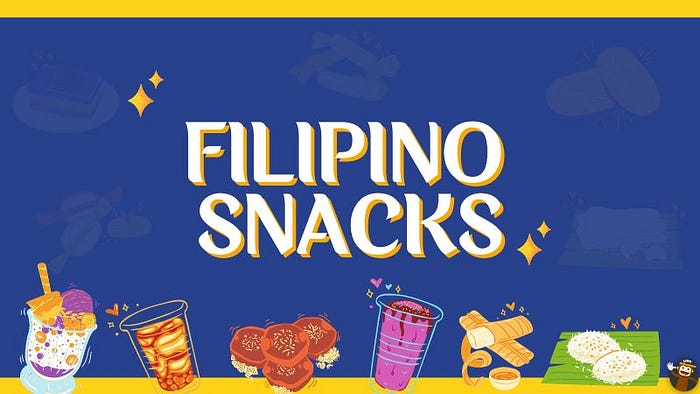
Found yourself craving delicious Filipino snacks? Here are some all-time favorite Filipino snacks or merienda (in Tagalog) that will make your mouth water!
Halo-halo, Balut, Lumpia. If you have watched any mukbang videos on Youtube that feature Filipino snacks, you might have heard these three. But, aside from these three snacks, there are a lot more delicious Filipino snacks that you must taste.
When you visit the Philippines, it’s inevitable to try their cuisine. Filipino cuisine is rich in delicious dishes that are unique in Filipino culture. They also have a fair share of delicious Filipino snacks that you can eat during merienda or light meals.
Filipino snacks usually are usually in different categories traditional kakanin (rice delicacies), chichirya (junk food/munchies), tinapay at biskwit (bread and biscuit), and others. Some Filipino snacks are influenced by other cultures, especially Spanish since they have been colonized for more than 300 years. There are also Filipino snacks that emerged purely in the Philippines.
Learning about these Filipino snacks is not only good for filling your empty stomach. It can also help you discover more about their culture and history, which is essential when visiting a country. So today, let’s learn about some delicious Filipino snacks you can try when visiting the Philippines.
All-Time Favorite Filipino Snacks
Filipinos love to have light meals or merienda throughout the day. By just listening to the word “merienda,” you will eventually figure out that snacking was an influence on the Spanish people when they were in the Philippines.
During merienda time, Filipinos love to eat different kinds of snacks. It’s perfect after taking a siesta or an afternoon nap. Filipino snacks are perfect because it’s not that heavy on the stomach, making you feel full and unable to eat dinner. They are just light meals that will satisfy your cravings.
Halo-Halo
Let’s start with one of the most popular Filipino snacks — halo-halo. It’s one of the Philippines’ favorite desserts. The word halo-halo literally translates to “mix-mix” in English. This is reasonable because it gives you an idea of what this delightful Filipino snack is all about.
Halo-halo is basically a very popular snack in the Philippines that is made by mixing different ingredients like caramelized banana, sweet potato, sago, gulaman, macapuno, ube halaya, sugar, evaporated milk, condensed milk, leche flan, and shaved ice. Mixing these ingredients might make you think twice about how it tastes, but the truth is, this is actually incredibly delicious. It’s sweet, delicious, and cold, which is perfect for the humid weather of the Philippines.

Balut
The next Filipino snack is probably one of the most interesting and bizarre because it’s made of a boiled duck egg with a little black chick curled up inside. It’s must-try street food, and if you wanna go to the Philippines, you must be “baptized” by eating a balut. Curious about what it tastes like? Well, there’s only one way to find out!
Taho

Waking up to the sound of a taho vendor or “magtataho,” as they call them, shouting “Taho!” is one of the best things in the Philippines. You will see people jumping out of their beds and chasing the taho vendor carrying their taho container.
Taho is popularly known as breakfast food made of silken tofu, arnibal, sago, and brown sugar. It is usually served hot. Although it is usually eaten in the morning, it can still be enjoyed at any time of the day. There are also other variants of taho, like chilled taho. In Baguio City, strawberry taho is enjoyed by the locals and tourists at any time of the day.
Lugaw

When you walk along the streets of the cities in the Philippines, you will probably see a “lugawan,” which can be an eatery or cart that sells lugaw or porridge. If you’re familiar with congee, lugaw comes from that. This delicious Filipino snack is made of rice, chicken broth, chicken pieces, ginger, scallions, and fried garlic to give it more flavor. It is also enjoyed with boiled eggs, lechong kawali, tofu, chicharon bulaklak, and more.
Lugaw is famous among Filipinos because it is easy to prepare and very affordable. In fact, this is one of the go-to food for a person if they don’t have enough budget. Just recently, a lugaw vendor named Mang Romy became trending because he is selling lugaw for only ₱2.00, which is around 0.098 only.
This Filipino snack is known to be a breakfast meal, but in the Philippines, you can enjoy it anytime you want, especially on rainy days. If you’re a Filipino, you might have heard the issue about lugaw being an essential food during the lockdown season. Of course, many Filipinos would agree that lugaw is really essential. It is cheap, it’s delicious, and most of all, it can fill a hungry stomach.
Champorado
Champorado is another breakfast meal but is also enjoyed as a snack. It is made of boiled glutinous rice and cocoa powder. After the champorado is cooked, condensed milk or sugar is added to make it even sweeter.
Champorado also has a colorful history. Champorado got its name from the Spanish drink champurrado, which is made with hot chocolate and cornstarch to thicken it. In the end, the Philippines made their own version by adding rice to the recipe.
There are many ways to enjoy this delightful snack. Some champorado is made with coconut milk, which gives the dish a fragrant aroma and a much richer taste. This version is best eaten with a salty side dish like tuyo (salted, dried fish) or bacon to offset the sweetness of the porridge.
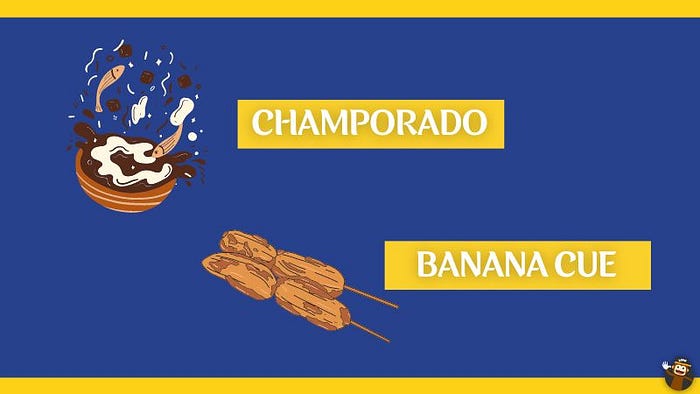
Banana Cue
Filipino snacks will never be complete without a banana cue. Banana cue is basically a deep-fried saba banana covered with brown sugar until it is caramelized. When it’s cooked, it will be put on skewers. This easy-to-prepare Filipino snack can be seen in the streets.
There is also another variant of this which is the kamote cue. The only difference is a sweet potato is used instead of bananas. It is prepared the same way and has only two ingredients.
Turon
Turon is another snack made with saba bananas. It’s kinda like banana cue, but turon is made of saba banana topped with brown sugar and wrapped with a flour wrapper. To make it more delicious, Filipinos also put slices of jackfruit inside. This sweet-flavored Filipino snack can be easily found on the streets with banana and kamote cues.
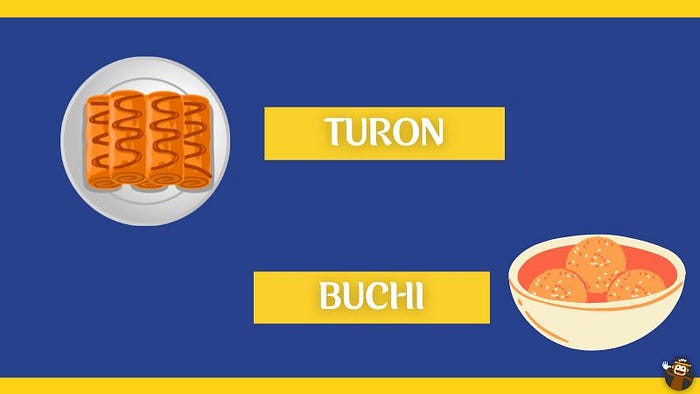
Buchi
This delicious Filipino snack is influenced by Chinese cuisine. It is the Filipino version of Jian dui. Buchi is a golden-brown ball made from glutinous rice flour, a sweet or savory filling, and a sesame seed coating. There’s a famous Chinese food chain in the Philippines called Chowking that sells delicious buchi.
Sweet Corn
Sweet corn is also a crowd’s favorite Filipino snack. They don’t actually have a Filipino translation of it, but if you translate “corn” in Tagalog, it is called “mais.” Mais is a Filipino snack that is usually popular with children.
There are two ways to enjoy sweet corn. It can be made of boiled corn on a cob that is seasoned with butter and salt. It can also be shredded and sprinkled with sugar, cheese powder, and margarine. Either way, you’ll definitely enjoy it.
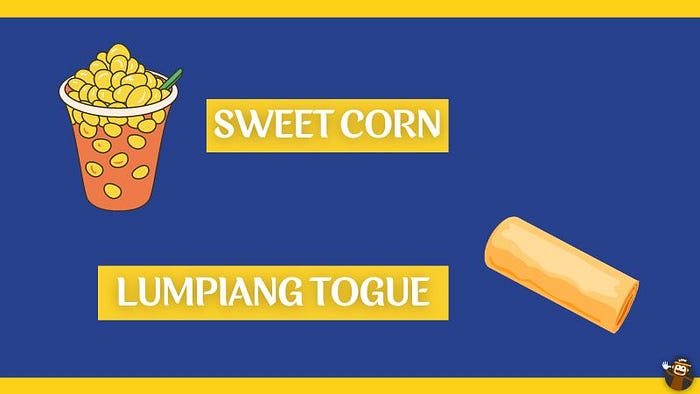
Lumpiang Togue
Lumpiang togue is kinda like spring rolls, but instead of meat, mung bean sprouts or tongue are used as the main ingredients. It is also mixed with carrots, green beans, fish sauce, garlic, and onion. After mixing all the ingredients, it will be wrapped in a spring roll wrapper and then fried. That’s not all; the highlight of eating it is dipping it in vinegar which makes it tastier.
Kakanin
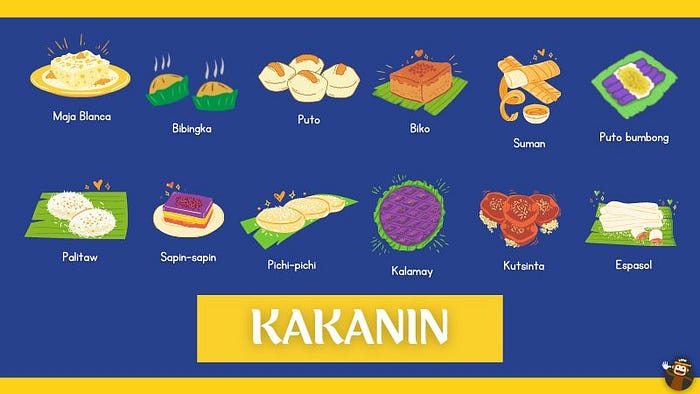
Filipino cuisine has an endless variety of kakanin or rice cakes. It has a significant value in Filipino culture. After a long day of labor, Filipinos have a craving for kakanin. They frequently purchase a slice or a piece of kakanin from merchants who set up shop at stalls or on the pavement.
Every rice cake is delicious in its own way. Some of the famous rice cakes that you’ll usually hear about are the following:
- Suman — It’s a Filipino rice cake made from glutinous rice cooked in coconut milk and wrapped in banana leaves. Suman is commonly served with mangoes, native chocolate drinks, or dipped in muscovado sugar.
- Biko — This mouthwatering indulgence can also be eaten as a merienda during the day. Brown sugar and coconut milk are the two main ingredients in this recipe.
- Bibingka — Bibingka is a baked rice cake originating in the Philippines. This cake is traditionally prepared in an oven made of terracotta and lined with banana leaves. Bibingka is typically consumed for breakfast or as a merienda, especially popular around the time of Christmas.
- Puto Bumbong — Puto bumbóng is a type of purple rice cake that is traditionally made in the Philippines and steamed in bamboo tubes. It is customary to sell during the Christmas season.
- Puto — It is a steamed cake snack that is popular in the Philippines and may be eaten at any time of the year. It is simple to prepare and consume, as well as transport. Traditionally, it is prepared by grinding rice, and it can be consumed either on its own or accompanied by butter or grated coconut. Top it with yema spread; it’s perfect.
- Kutsinta — Kutsinta (also known as cuchinta) are steamed cakes that are traditionally produced in the Philippines using flour, tapioca flour, and brown sugar. They are a fantastic option for either breakfast or dessert, thanks to their chewy texture and topping of grated coconut.
There are other varieties of kakanin in the Filipino cuisine like palitaw, sapin-sapin, maja blanca, nilupak, kalamay, pichi-pichi, and espasol. But, it would be much better if we discussed this in a separate blog.
Ensaymada
Filipino snacks are also rich in pastries, and one of the most favorite types of pastry is ensaymada. Ensaymada is a Spanish-influenced baked snack. This sweet dough pastry is soft and covered with butter and sugar before having a generous amount of shredded cheese sprinkled on top. It is also blessed to partner with coffee.

Chicharron
When you’re a Filipino, it’s impossible not to love Chicharron or pork rinds. This crunchy snack is fried in oil at a high temperature, then seasoned with salt, pepper, vinegar, and garlic. It is best enjoyed with seasoned vinegar.
Of course, when you hear the word pork rinds, you’ll definitely worry about fats, but chicharon is extremely low in carbs. It may also be substituted for salty and crunchy snacks like chips, crackers, and other similar foods
Banana Chips
Banana chips are also a popular snack in the Philippines since they have abundant resources for bananas. The Tagalog word for banana is “saging.” Banana chips are pieces of banana that have been fried until they are crisp and are typically eaten as a snack. Some of the banana slices are baked, while others are dried or fried in deep oil.
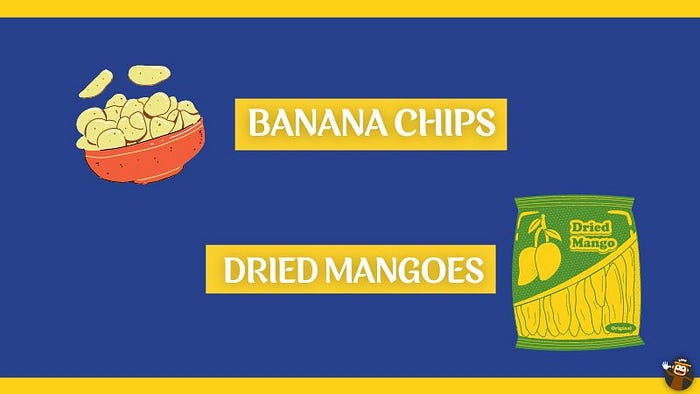
Dried Mangoes
The Philippines is rich in tropical fruits like mango. That’s why they have a lot of mango snacks and drinks to offer. One of these is dried mangoes. When it comes to dried mangoes, one of the most popular is those that came from Cebu.
There is no exact translation of dried mango in Tagalog, but the word mango is translated as “manga” in Tagalog, and the word “dried” is translated as “pinatuyo.” Turning mangoes into snacks is also a solution to the country’s overproduction of mangoes. After all, mango is the country’s national fruit.
Manggang Hilaw
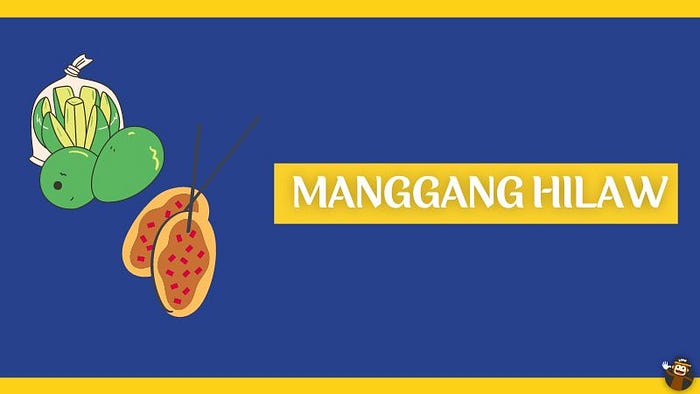
Imagine an unripe mango topped with bagoong (a paste made from fermented or salted fish). Well, if this will not give you a sour face, then I don’t know what else would. As mentioned above, mango is the country’s national fruit, and they have many dishes and snacks made from it. One of the most popular ones is manggang hilaw.
The word “mangga” means “mango” and “hilaw” means “unwripe”. Manggang hilaw is basically unripe mangoes that are sliced and usually deeper in bagoong. When I say unripe, these are really sour mangoes. You might think that it’s hard to eat a mango with extreme sourness, but bagoong does the magic to balance it out.
Ihaw-Ihaw

We cannot talk about Filipino snacks without mentioning ihaw-ihaw. The word “ihaw” is a root word for words like inihaw (grilled). Basically, ihaw-ihaw refers to grilled snacks. The most common grilled snacks are barbecue, isaw (chicken or pork intestine), paa ng manok (chicken feet), dugo or betamax (pig’s blood), ulo ng manok (chicken’s head), and atay ng baboy (pig’s liver). These are usually dipped in seasoned vinegar.
Ihaw-ihaw is a special part of Filipino cuisine and Filipino culture. It is a kind of street food usually found on a street and bought at a low price. Some might find it weird to eat these parts of a pig and chicken, but for many Filipinos, it has always been part of their merienda list.
Tusok-tusok

Another famous form of snack is the tusok-tusok.Tusok-tusok is a collective name for snacks like fishballs, squid balls, chicken balls, kikiam, and kwek-kwek. The word “tusok” or “tusukin” is an act of piercing something with a pointed object. This tells a lot about these kinds of snacks because tusok-tusok are cooked in a large pot, and the vendor just allows the customers to pierce them using skewers.
Even up to this day, tusok-tusok is still on the top list of Filipino snacks, along with ihaw-ihaw and kakanin. You’ll easily see them along the streets; the best part is they are affordable.
Dirty Ice Cream
Before anything else, let us clarify that dirty ice cream doesn’t literally mean that it is really dirty. It is just a name the locals give because this kind of ice cream is usually sold in the streets with the iconic ice cream vendor pushing his colorful cart. When you hear the bell, you’ll see that children will come rushing outside their houses to chase the dirty ice cream cart. It’s a perfect snack for the country’s humid weather.
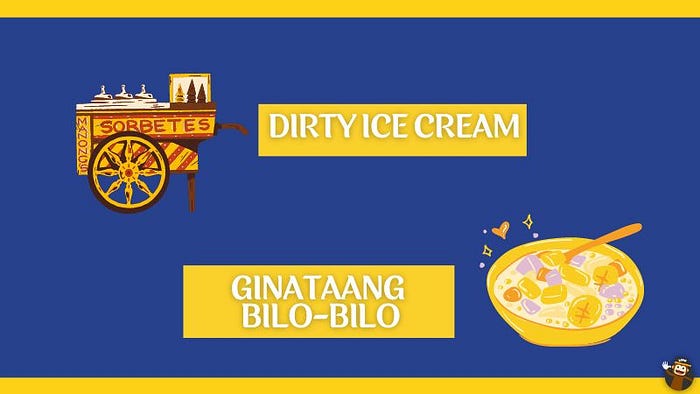
Ginataang Bilo-Bilo
Lastly, let’s talk about a Filipino snack that is especially famous during the holy week — Ginataang Bilo-bilo. A dessert soup called ginataang bilo-bilo is made with tapioca, chewy rice balls, and a variety of fruits and tubers. It is based on coconut milk and has a sweet flavor.
Other Filipino Snacks
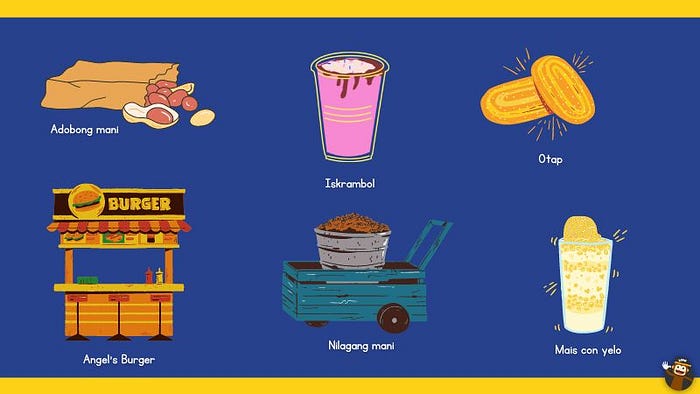
The list above is the common Filipino snacks that the locals enjoy during merienda time. But, it doesn’t include junk food/chips or chichiria like the famous Regent Golden Sweet Corn, Chippy, Chiz curls, and more. This is an interesting topic that should be discussed separately, so let us learn more about Filipino snacks.
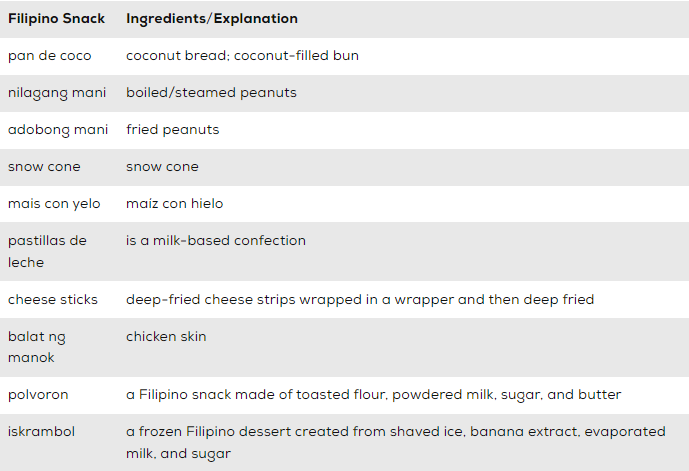

Snack While Learning Tagalog With Ling!
Learning a language while snacking is maybe one of the best things to do nowadays. Of course, you cannot do it in language school, but with Ling App, you can learn a language anytime and anywhere, so if you wanna a snack while learning, that wouldn’t be a problem.
Learning Tagalog and other languages with Ling App feels like playing a game. There’s no pressure because each lesson is developed to be engaging and meaningful. With Ling App, you can develop all your language skills to achieve your language learning goals.
